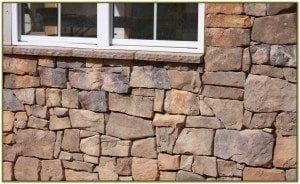If the manufactured stone veneer in your home was installed correctly, it’s unlikely that you will find moisture damage, even in the wettest winter. However if precast simulated stone is not installed properly, and flashing is inadequate, water can quickly cause extensive structural damage.
Even if you can’t see any form of damage on wall surfaces, it’s essential to inspect your home and manufactured stone veneer for moisture damage. The reality is that most homeowners (and inspectors for that matter) don’t recognize moisture problems until it has set in and caused costly damage. Often they only realize that there is damage when telltale signs of leaking water become visible.
Building codes do set standards for the installation of manufactured stone veneer, including water-restricting barriers, flashing, and metal weep screeds. These are, though, minimal standards, and inexperienced or unscrupulous contractors don’t always follow them. Unfortunately construction is difficult to police because the building process is quick and the window for inspection is short. For example, barriers inside the structure that restrict water and vapor cannot be inspected once the house is complete unless the wall is opened up.
Ideally contractors should be forced to allow a certified InterNACH (International Association of Certified Home Inspectors) inspector to inspect the structure prior to completion.
About Manufactured Stone Veneer
Unlike cast stone that is normally used to build load-bearing walls on concrete foundations, manufactured stone veneer is a relatively lightweight product that does not require a foundation. It can be applied to most structures including wood and metal frames, enabling builders to achieve the aesthetic effect of real stone quickly and cost effectively.
While easy to install, if installation is not done correctly, serious water damage can occur over quite short periods of time – as little as two years. Because there is no air space between framed walls and cladding, the need for well-designed flashing is critical. If water cannot drain, even a seasonal rainstorm could cause damage.
Of course the ideal is to ensure that installation is done the right way. This checklist may be used for a thorough inspection:
- Generally, if only mortar is visible between the veneer units, the veneer has been correctly installed. However design must include the specifications outlined in the building codes.
- There should be weep screeds at the base of all wood-frame walls and at the tops of windows and doors.
- Seams and joints around windows and doors, and where the manufactured veneer meets other cladding must be sealed. Manufactured stone windowsills that slope away from the building will aid drainage.
- Flashing that is corrosion-resistant should be installed with a bedding seal under the flashing and with a drip edge. Water-resistant barriers should also lap over the flashing’s back edge for water to drain.
- Veneer should not be in contact with ground surfaces or any part of the roof. This is a common fault that leads to water damage.
- Kick-out flashing should divert water away from the building (and the veneer) to prevent water from penetrating the cladding and causing the structure to rot, or in the case of a metal frame, rust.
For additional protection, a good quality stone-sealing product like Natural Shield should be used. This will prime the surface and help to prevent water from penetrating. It will also reduce and minimize the possibility of freeze and thaw damage, cracking and stains.
How to Inspect Your Home and Manufactured Stone Veneer for Water Damage
Once you have inspected the installation of flashing and so on, look for evidence of water damage. Moisture inside walls will often cause efflorescence that shows up on the surface in the form of chalky powder. Check inside wall surface carefully for signs of mold or discoloration. Also run your hand over wall surfaces; if they feel cold and damp you can be sure you have water damage inside the wall structure.
If there is any evidence of moisture inside walls, they will have to be opened up, cleaned, and any damaged material replaced. The longer you leave it, the worse the problem will become, and the more repairs are likely to cost you.
If you do have to open up and repair walls, ensure that flashing and other water-repellent installations are done correctly second time around. Also be sure to coat all manufactured stone veneer surfaces with Natural Shield for maximum protection.




Follow Us!